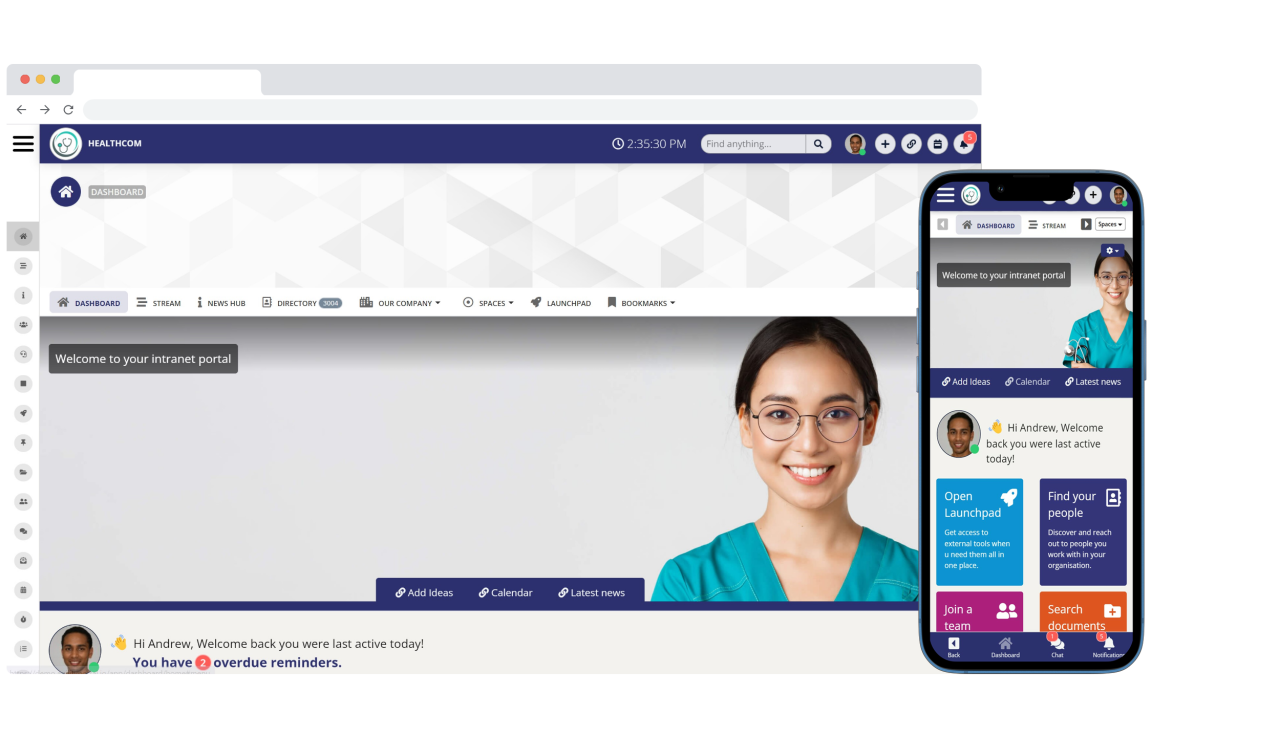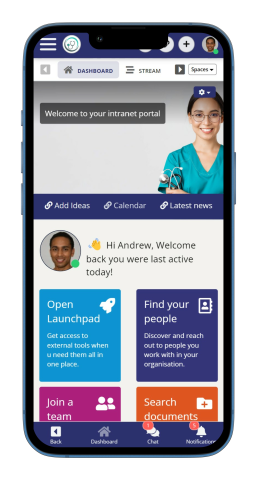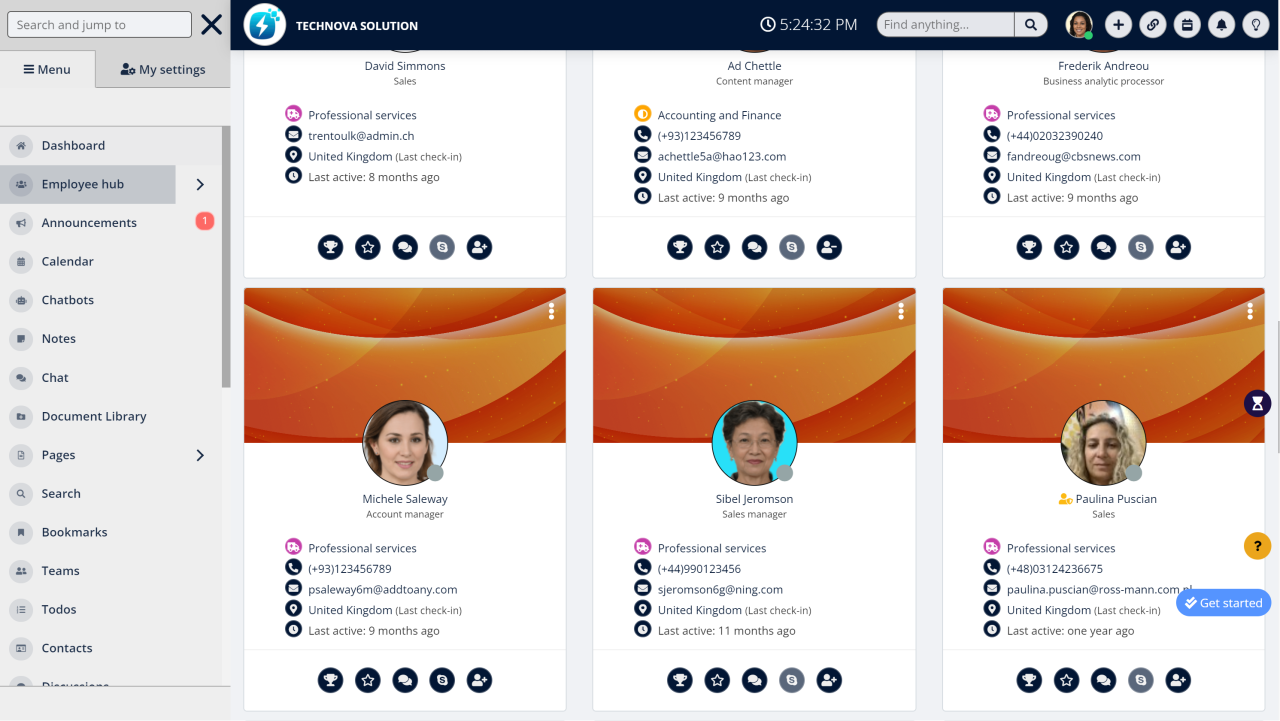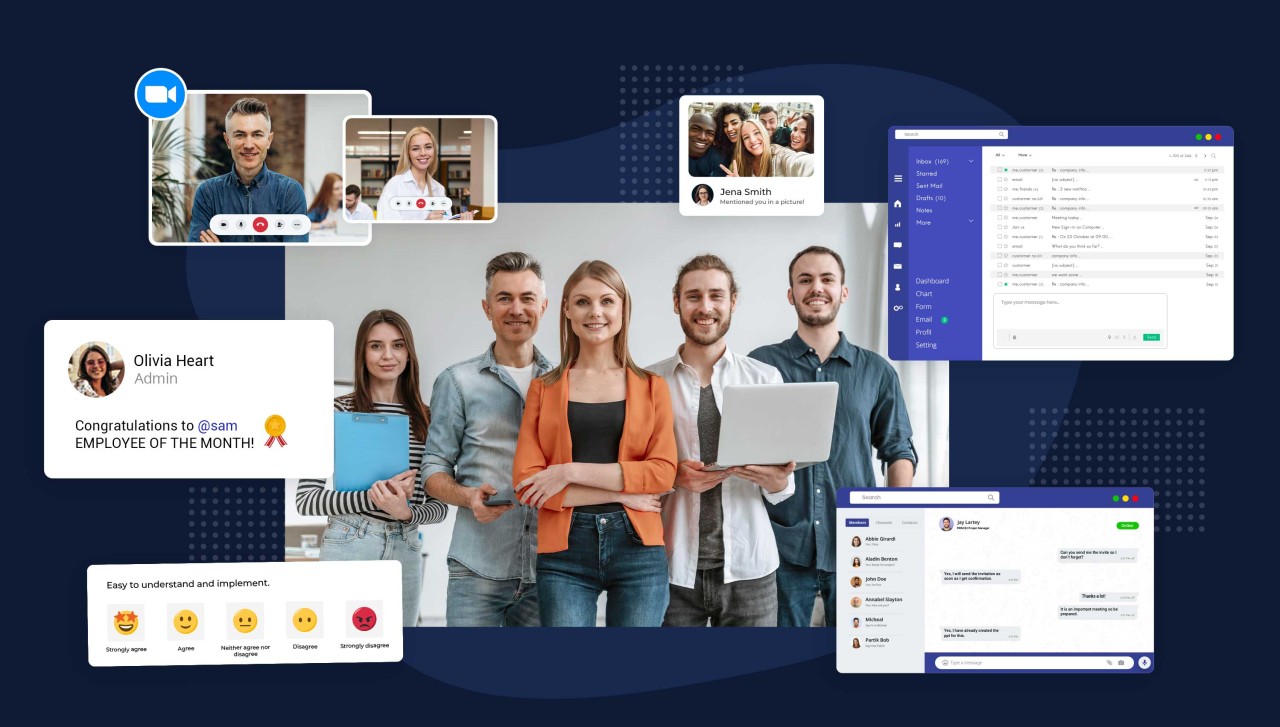Insight Blog
Agility’s perspectives on transforming the employee's experience throughout remote transformation using connected enterprise tools.
18 minutes reading time
(3569 words)
What Is An Employee Social Network?
In today's fast-paced and interconnected world, the concept of an Employee Social Network (ESN) is gaining increasing prominence within organizations.
In today's fast-paced and interconnected world, the concept of an Employee Social Network (ESN) is gaining increasing prominence within organizations.
In 2014, as per Pew Research Center, 77 percent of employees indicated that they used social media while at work.
An ESN is a private and secure online platform designed to facilitate communication, collaboration, and networking among employees within a company.
It serves as an internal social networking tool tailored specifically for the workplace, and it has the potential to transform how employees interact and collaborate with one another.
Effective communication and collaboration are the lifeblood of thriving workplaces. Regardless of whether your company operates in a fully remote or traditional brick-and-mortar office setting, maintaining strong connections among teams and employees is essential for productive teamwork.
While this necessity is clear, the path to fostering such connections isn't always straightforward.
Enter the enterprise social network (ESN), a powerful solution that businesses utilize to create a private, internal social network for their teams to connect and collaborate seamlessly across the organization.
An ESN typically integrates elements of team messaging, project management, task coordination, and collaboration tools into a unified platform. By breaking down communication barriers and promoting cross-silo interactions, an ESN cultivates a culture of enhanced employee engagement and the generation of innovative ideas.
In this article, we will thoroughly explore enterprise social networking tools, delving into their definition, essential features, and the value they bring to both organizations and employees.
The history of enterprise social networking or ESN
Let's explore the evolution of enterprise social networks (ESNs) and the reasons behind their emergence.
Back in the early 1990s, during the nascent years of the internet, people began to harness the web's potential to connect and build communities around shared interests.
Platforms like theGlobe.com and Geocities, which recently closed its doors after nearly 25 years of operation, provided all-in-one solutions for sharing content online.
These early social networks gained immense popularity, attracting not only individuals but also advertisers keen to tap into the burgeoning online community.
From these early online platforms, we witnessed the birth of the modern social media giants we use today, such as Facebook, Twitter, and LinkedIn. Inspired by the resounding success of these consumer-focused networks, enterprise-focused social networks like Yammer and Jabber began to emerge and gain momentum.
Yammer, for instance, was conceived as an internal business-focused social network, akin to Facebook but tailored for corporate use. It offered a user-friendly interface that facilitated communication among colleagues and featured an activity feed showcasing colleagues' latest actions and content.
Recognizing the value of having a single platform for communication and collaboration, businesses embraced Yammer, making it easier to align all employees and keep them informed. In 2012, Microsoft acquired Yammer and leveraged its model to develop Microsoft Teams.
What Is an Enterprise Social Network?
An Enterprise Social Network (ESN) also known as social software, intranet software, employee communication app is a private and secure digital platform designed for businesses and organizations to facilitate internal communication, collaboration, and networking among employees.
ESNs are built to resemble social media networks but are exclusively used within the corporate environment.
The primary purpose of an ESN is to improve internal communication, foster collaboration, and create a sense of community among employees.
By breaking down communication barriers and promoting cross-functional interactions, ESNs aim to enhance employee engagement, boost productivity, and encourage the exchange of innovative ideas within the organization.
Here are a few exmaples.
1.Social Media Networks
Many of us are well-acquainted with popular external social networking platforms like Facebook, Twitter, Instagram, and LinkedIn. These platforms enable individuals to connect, follow each other, and engage in communication through a variety of tools.
However, it's important to note that public social media platforms aren't typically designed for workplace communication. There are several compelling reasons why encouraging team members to use a company-wide communication network is a more sensible choice.
- User Profiles: Users can create and customize their profiles, providing information about themselves, such as their name, profile picture, bio, and personal interests.
- Friend or Follower System: Users can connect with others by sending friend requests or following their profiles. This allows users to see each other's updates and content.
- News Feed: A central feed or timeline displays posts, updates, and content shared by users and the profiles they follow. It serves as the primary content hub.
- Content Sharing: Users can share various types of content, including text posts, images, videos, links, and documents, with their network.
- Likes, Comments, and Shares**: Users can engage with posts by liking them, leaving comments, or sharing them with their network, fostering interaction and discussions.
- Privacy Settings: Users can adjust the visibility of their posts and profile information, controlling who can see their content, often categorized as Public, friends-only, or custom settings.
- Messaging and Chat: Many social media networks offer private messaging and chat features, allowing users to have one-on-one or group conversations.
- Notifications: Users receive real-time notifications about interactions on their content, such as likes, comments, and new followers, helping them stay engaged.
- Search and Discovery: Users can search for other users, groups, or content based on keywords, hashtags, or specific criteria.
- Groups and Communities: Users can join or create groups or communities based on shared interests, hobbies, or topics, facilitating focused discussions and content sharing.
- Events and Calendars: Some social networks offer event creation and management features, allowing users to organize and promote events, others can RSVP.
- Analytics and Insights: For business or influencer profiles, analytics tools provide data on post engagement, audience demographics, and performance metrics.
- Advertising and Promotions: Social media networks often offer advertising platforms for businesses to reach a wider audience through paid campaigns.
- Live Streaming: Many platforms support live video streaming, enabling users to broadcast in real-time and engage with their audience.
- APIs and Integrations: Developers can use APIs (Application Programming Interfaces) to create third-party apps and integrations that enhance the user experience.
- Mobile Apps: Most social media networks offer mobile applications for smartphones and tablets, ensuring accessibility on the go.
These features vary across different social media platforms, and some platforms may have unique features tailored to specific purposes, such as professional networking (e.g., LinkedIn) or visual content sharing (e.g., Instagram).
2.Enterprise social networking
An Enterprise Social Network (ESN) serves as a centralized communication platform, essentially a private social network exclusive to an organization's staff.
Within this enterprise collaboration software, a suite of collaboration tools is designed to foster informal and social communication, aid in task management, and contribute to enhancing employee morale.
There are several products available that fall under the category of Enterprise Social Networks or possess enterprise social networking capabilities. These include:
Within this enterprise collaboration software, a suite of collaboration tools is designed to foster informal and social communication, aid in task management, and contribute to enhancing employee morale.
There are several products available that fall under the category of Enterprise Social Networks or possess enterprise social networking capabilities. These include:
Here are some examples of enterprise social networking (ESN) software:
- Microsoft Yammer
- AgilityPortal
- Workplace from Meta
- Slack
- Jive
- Google Workspace
These platforms offer a variety of features for communication, collaboration, and knowledge sharing, such as:
- Social news feeds: Employees can see updates from their colleagues, company leaders, and other groups they follow.
- Groups and communities: Employees can join groups based on their interests, teams, or projects.
- Instant messaging: Employees can chat with each other in real time, both individually and in groups.
- Document sharing: Employees can easily share documents and other files with each other, both individually and within groups.
- Other features: Many ESNs also offer other features, such as wikis, blogs, polls, and surveys.
ESNs can be used for a variety of purposes, such as:
- Communication and collaboration: ESNs can help employees to communicate and collaborate more effectively, regardless of their location or department.
- Knowledge sharing: ESNs can help employees to share knowledge and expertise with each other, which can lead to improved decision-making and problem-solving.
- Employee engagement: ESNs can help to increase employee engagement by providing employees with a way to connect with each other and share ideas.
Here is an example of how an ESN might be used in a real-world setting:
A company is launching a new product line. The product development team uses the company's ESN to communicate and collaborate with each other, as well as with other teams in the company, such as marketing, sales, and customer support. The team uses the ESN to share documents, files, and ideas, as well as to get feedback from other employees. The ESN also helps the team to stay up-to-date on the latest developments related to the new product line.
Once the product is launched, the team uses the ESN to communicate with customers and get feedback on the new product. The team also uses the ESN to share knowledge and expertise with customers.
ESNs can be a valuable tool for organizations of all sizes. They can help to improve communication and collaboration, increase employee engagement, and reduce knowledge silos.
Why Do Business Introduce Enterprise Social Networks in the Workplace?
According to a study conducted by the McKinsey Global Institute (MGI), the untapped potential in harnessing social tools to enhance communication, knowledge sharing, and collaboration within and across enterprises is remarkable.
The study reveals that by fully embracing social technologies, companies have the potential to boost the productivity of interaction workers—highly skilled knowledge workers, including managers and professionals—by a substantial 20% to 25%.
Enterprises that successfully implement an enterprise social network (ESN) stand to benefit significantly. These networks pave the way for more streamlined and effective work processes, heightened employee engagement, and enhanced management of tasks and projects. With the addition of enterprise messaging software, organizations further simplify real-time communication and reduce reliance on emails.Statistics indicate that organizations adopting ESNs have experienced remarkable outcomes. They have found these networks to be powerful tools for communication and collaboration across diverse locations and hierarchical structures.
ESNs enable the sharing of company-wide announcements, facilitate spontaneous conversations, and champion the adherence to business processes and values.
For instance, an ESN can drastically reduce internal email traffic by introducing instant messaging capabilities. Team messaging fosters quicker and more effective communication while promoting real-time, two-way conversations.
In addition to these advantages, Enterprise Social Networks offer the following benefits:
Furthermore, ESNs play a pivotal role in supporting employee engagement, fostering a sense of community, and amplifying the organizational culture. They enable employees to socialize with their colleagues and acknowledge each other's achievements.
For instance, an ESN can drastically reduce internal email traffic by introducing instant messaging capabilities. Team messaging fosters quicker and more effective communication while promoting real-time, two-way conversations.
In addition to these advantages, Enterprise Social Networks offer the following benefits:
- Creation of Virtual Spaces: ESNs provide virtual spaces tailored for specific groups or teams.
- Facilitation of Cross-Team Collaboration: Serving as a central communication hub, ESNs encourage collaboration among teams from different departments.
- Enhanced Communication in Remote Teams: ESNs bridge the communication gap within remote teams, ensuring that they stay connected and informed.
- Centralized Knowledge Repository: Employees can easily ask questions and locate individuals across the organization using a centralized knowledge repository.
- Support for Professional Communities: ESNs nurture professional communities with shared business interests, such as chefs in various locations sharing culinary inspiration.
- Document Management: ESNs provide access to essential resources that support daily work, effectively merging traditional intranet functions with modern collaboration tools.
Furthermore, ESNs play a pivotal role in supporting employee engagement, fostering a sense of community, and amplifying the organizational culture. They enable employees to socialize with their colleagues and acknowledge each other's achievements.
What are the Benefits of ESNs
Many companies turn to Enterprise Social Networks (ESNs) to bridge communication gaps within their broader teams. ESNs prove particularly valuable for businesses with geographically dispersed teams, offering a more efficient means of interacting with colleagues worldwide compared to traditional methods like phone calls and emails.
However, using an ESN solely for communication and socialization often overlooks its potential as an enterprise-wide network. Relying on a multitude of disparate tools and software for collaboration, task management, document sharing, and editing can lead to lost productivity due to constant context-switching during the workday.
To maximize the benefits of an ESN, it's crucial to select a platform that seamlessly integrates with collaboration and document-sharing tools, transforming it into a central hub for your organization's communication and collaboration needs. This integration ensures that no one wastes time hunting for conversations or documents scattered across various tools.
This approach is substantiated by research. Harvard Business Review found that teams using ESNs experienced improved collaboration and knowledge sharing across organizational silos.
This, in turn, led to faster decision-making, the generation of more innovative ideas, and heightened engagement among team members and with their work and company.
ESNs play a pivotal role in accelerating decision-making, fostering innovation, and boosting employee engagement.
Returning to the history of ESNs, around the same time Microsoft acquired Yammer, McKinsey Global Institute conducted a study revealing that 72% of companies were utilizing social technologies to enhance their business operations.
However, the study noted that very few were fully realizing the potential benefits.
McKinsey estimated that companies had the opportunity to increase the productivity of managers and high-skill workers by 20-25% through the implementation of various social technologies and software solutions that enhance communication, knowledge sharing, and collaboration both within and across businesses.
So, how can your organization unlock this potential?
What are the Features of ESNs
An employee social media platform comprises various features designed to engage and empower employees, regardless of their work locations.
1.Employee directory
Enterprise social networks (ESNs) provide employees with a way to connect, communicate, and collaborate with each other. One of the key features of ESNs is the employee directory.
Employees can post their professional profiles in the employee directory. The profile can include the employee's skills, department, location, education, and anything else the employee wishes to share. This information can help employees to connect with each other and find experts in their field.
When someone in the company wants to connect with an expert, they can consult the employee directory. The directory can also highlight employees' special skills and talents that may not be immediately obvious from their job titles.
For example, an employee who is working on a new project may want to connect with an expert in a particular area. The employee can consult the employee directory to find an expert in their field. The directory can also help employees to find experts who may be able to provide feedback on their work.
2.HR Portal, Teams, Groups, and Spaces
Employees require an effective HR communication portal to access a range of essential information, documents, news updates, and various resources. This HR portal serves multiple purposes, such as sending reminders to employees about significant dates like open enrollment periods.
Additionally, it functions as a platform for addressing common queries, announcing new team members, and sharing news about internal transitions within the company.
Furthermore, the HR portal serves as a valuable tool for conducting employee surveys to gather feedback, hosting an internal job board, and offering shortcuts to HR applications, streamlining various HR-related tasks for employees.
3.Onboarding new staff
The onboarding center plays a crucial role in ensuring that the initial days and weeks of a new employee's journey with the company are both enjoyable and productive.
This resource acts as a guiding light, leading the new hire through a series of well-defined steps aimed at fostering a strong connection and engagement with the organization right from the outset.
What sets this process apart is its personalized approach, tailored to each individual, providing clarity and manageability throughout. By streamlining the onboarding experience, it effectively minimizes the time required for a new hire to become fully acclimated to their new workplace.
4.Media center
The corporate video center serves as an extensive repository for both internal and external video content. This catalog encompasses a wide array of materials, encompassing onboarding resources, training videos, sales assets, and marketing materials.
These videos find their home within platforms such as AgilityPortal, and they can also be externally linked to YouTube for easy access. The content can be further customized, offering users the choice of viewing videos either through thumbnail previews or in a convenient list format.
5.Idea managment
An Enterprise Social Network (ESN) can play a significant role in idea management by providing a platform for employees to collaborate, share, and develop innovative ideas.
6.Goal tracking
An Enterprise Social Network (ESN) should serve as a tool that breathes life into company goals and values. It accomplishes this by offering effortless access to relevant posts and the capability to align posted content with specific company objectives.
This strategic synchronization offers employees an intuitive means to structure their daily tasks in alignment with the organization's overarching goals and values.
7.A place for collaboration
Your Enterprise Social Network (ESN) should empower you to engage in collaborative efforts with colleagues, regardless of their location or department, through the use of groups or workspaces.
For instance, in AgilityPortal, this functionality is referred to as "Spaces," and it proves invaluable for sharing specific updates, asking questions, and offering commendations.
You can create, Teams, Groups, Brand, Departments and many other more.
Additionally, an ideal ESN should grant you the capability to distribute content seamlessly across multiple groups for broader reach and visibility.
8.Integration with other apps
Ideally, your Enterprise Social Network should come equipped with ready-to-use integrations that seamlessly connect with other communication applications, content management systems, and event platforms like the RegFox conference event registration platform. This ensures that employees can access essential information from a single, centralized source.
As an illustration, consider AgilityPortal, which offers integration capabilities with SharePoint, Slack, Zoom, and Microsoft Teams. With these integrations, employees can conveniently access various apps and content directly from the activity feed.
Moreover, AgilityPortal enables real-time chat integration with Slack and Teams, facilitating direct communication through top-notch messaging technology directly from the activity feed.
This streamlines communication and information access for enhanced efficiency.
9.For sending communication
An Enterprise Social Network (ESN) should provide the means for your CEO or leadership team to establish effective communication and foster a dialogue with all employees using diverse channels. These channels may include updates, blogs, and even town hall meetings.
For instance, using AgilityPortal, you have the convenience of seamlessly embedding Zoom meeting invitations and commencing meetings directly from content posts or news and events announcements.
AgilityPortal, with its integrated video conferencing capabilities, enables unlimited video calls with all members of your organization.
This integrated approach simplifies the process of engaging with employees and conducting important meetings.
Built in real-time chat, for connecting all employees.
10.Get employee feedback
Collecting employee feedback should be a straightforward process. AgilityPortal offers convenient and swift survey tools that facilitate frequent pulse checks on employee sentiment.
This approach empowers organizations to gather valuable feedback from their employees with ease. Tools such as Forms, Surveys, and Polls.
Follow us and access great exclusive content everyday: Follow us on Google News
How to use an enterprise social network effectively in your organisation.
To use an enterprise social network (ESN) effectively in your organization, you should:
- Set clear goals and expectations. What do you want to achieve with your ESN? Do you want to improve communication and collaboration, increase employee engagement, or share knowledge more effectively? Once you know your goals, you can start to develop a plan for how to achieve them.
- Choose the right ESN for your organization. There are many different ESNs on the market, so it is important to choose one that is right for your organization's needs. Consider factors such as the size of your organization, the industries and markets you serve, your budget, and the features that are important to you and your employees.
- Implement and adopt the ESN effectively. Once you have chosen an ESN, you need to develop a plan for implementation and adoption. This plan should include training for employees on how to use the ESN and best practices for communication and collaboration. You should also promote the ESN to employees and encourage them to use it.
- Monitor and measure your progress. Once the ESN is in place, it is important to monitor and measure your progress to ensure that you are achieving your goals. You can use analytics and reporting features to track engagement and measure the impact of your ESN initiatives.
Here are some additional tips for using an ESN effectively:
- Create a content strategy. What kind of content do you want to share on your ESN? How often will you share content? You should develop a content strategy that will help you to achieve your goals.
- Encourage employee engagement. The more employees use the ESN, the more valuable it will be for the organization. Encourage employees to share their ideas, ask questions, and collaborate with each other.
- Use the ESN to recognize and reward employees. You can use the ESN to recognize and reward employees for their contributions. This can help to increase employee engagement and morale.
- Monitor the ESN for inappropriate content. It is important to monitor the ESN for inappropriate content, such as harassment or discrimination. You should also have a policy in place for dealing with inappropriate content.
Free ebook: How To Get Your Intranet Off The Ground
Book a demo of our employee app today to see how you can build your very own Enterprise Social Network, and keep all employees engaged in one place.
Categories
Blog
(2610)
Business Management
(320)
Employee Engagement
(208)
Digital Transformation
(173)
Growth
(119)
Intranets
(119)
Remote Work
(61)
Sales
(48)
Collaboration
(37)
Culture
(29)
Project management
(29)
Customer Experience
(26)
Knowledge Management
(21)
Leadership
(20)
Comparisons
(6)
News
(0)
Ready to learn more? 👍
One platform to optimize, manage and track all of your teams. Your new digital workplace is a click away. 🚀
Free for 14 days, no credit card required.

















